Table of Contents
Do you want to propagate your existing rosemary plant? Cutting from a grown rosemary plant is the best method for starting a new one. Donating cuttings from your plant is an excellent idea if it has many healthy stems at least six inches long.
So, do you want to know when to take rosemary cuttings? Growing cuttings do not require a greenhouse or any other specialised tools. All you require is a donor plant, water, soil, fertiliser, and a protected space (indoors or outdoors).
While growing rosemary from its seed is an option, growing it from cuttings will be an interesting experience. The best part is that individuals do not need the rosemary plant.
A Step-by-Step Process to Propagate Rosemary from Cuttings
Here’s how to propagate fresh rosemary plants from cuttings taken from a mother plant:
Step 1: Select a Stem
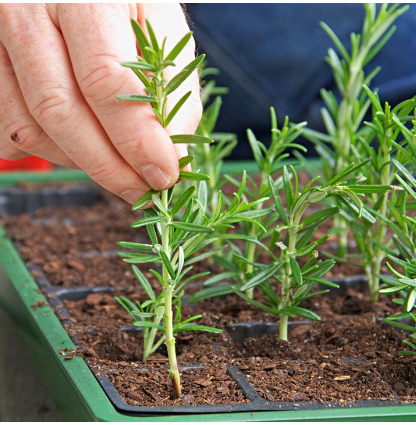
A pair of sharp pruning shears should be ready before you begin the propagation process. Damage to the parent plant from employing blunt shears might hamper subsequent regeneration. To stop the spread of illness, they must be cleaned completely. The next step is to locate a robust stem with signs of recent development. Instead of the dark green and woody feel of the lower stems, the upper ones will be a brighter shade of green. The node where the old and new stems meet should be a natural breaking point for the stems. Don’t choose stems that are wilting or bruised. Damaged or infected cuttings will either not root well or spread the condition to the new plant.
Step 2: Make a Cutting
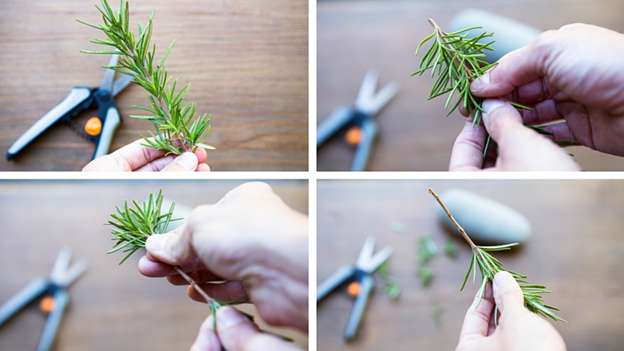
Once you have settled on the perfect stem (or stems), you may begin chopping. First, cut off at least four inches of stem, removing softwood from the base of the cutting. Before spreading the cutting, use your shears to remove any hardwood residue. You do not have to worry; it won’t make your plant look dull. When the propagation begins, these stems will most likely regrow and produce new ones in spring. In the spring, rosemary should be pruned by cutting it back, accomplishing two tasks simultaneously. Make a shallow cut into the stem at an angle below one of the sets of leaves. If you have trouble cutting through a stem, try using sharper shears or selecting a stem with weaker growth when taking rosemary cuttings. Collect as many stem segments as you would want to grow. If there is sufficient new growth on the plant, three may fit in a pot of medium size. Your rosemary may go as long as four inches if you choose.
Step 3: Get Rid of The Foliage
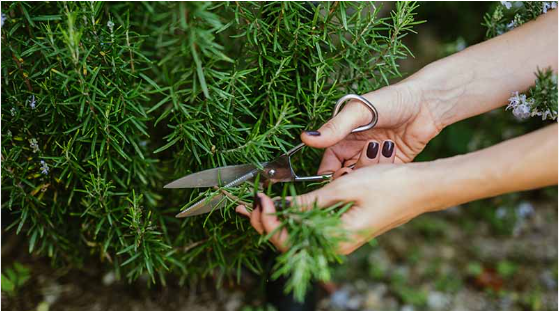
Once you have your cuttings and know when to take rosemary cuttings, you should prune off the lower half of the stem to expose the new growth. Next, take off the lowest two or three leaves of a cutting used for a centrepiece. Carefully pry them off so as not to break off any stem. Leave a crown of leaves of at least two inches in height. Photosynthesis occurs in these leaves and supplies the plant with the energy it needs to develop roots. There can be no root development without these leaves. To encourage root development, it is necessary to remove the leaves. In addition, it keeps the leaves from decomposing below ground, where they may attract pests. In time, the cut’s visible portions will be buried. Also, prune the cutting of any flowers that are either in bloom or have faded. These eat up resources that might be used toward root development in the cutting. Any unhealthy or broken leaves may be removed now for a better harvest.
Step 4: Apply Rooting Hormone
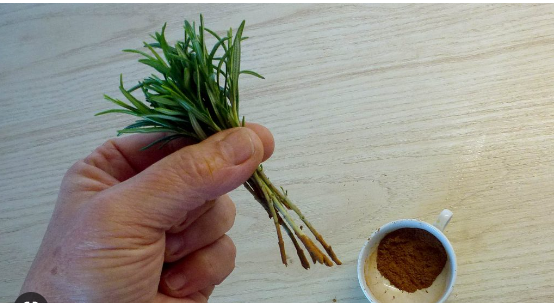
Once you have your cuttings and know when to take rosemary cuttings, you should prune off the lower half of the stem to expose the new growth. Next, take off the lowest two or three leaves of a cutting used for a centrepiece. Carefully pry them off so as not to break off any stem. Leave a crown of leaves of at least two inches in height. Photosynthesis occurs in these leaves and supplies the plant with the energy it needs to develop roots. There can be no root development without these leaves. Prepare a rooting hormone powder by dipping the cuttings’ ends in water. To avoid contaminating other food with germs, it is recommended to pour off a small amount from the bottle onto a separate plate before eating. For the same reason, the new rooting hormone should never be returned to its original container.
Step 5: Rooting
The next step, rooting, is simple. There are two possible outcomes here. First, the cuttings may be embedded in water or planted directly into the soil.
Water-based roots
In this rooting process, you must place rosemary cuttings in a glass half-filled with water. However, it is crucial to know when to take rosemary cuttings in the UK to submerge them in the water. The only way to keep the leaves from decaying is to keep them out of the water. Additionally, it is best to know that purified water is your best bet for propagating rosemary. However, several tap water contaminants might stunt the development of sensitive cuttings. However, you can use normal water if you do not have purified water. But, ensure to boil it before use.
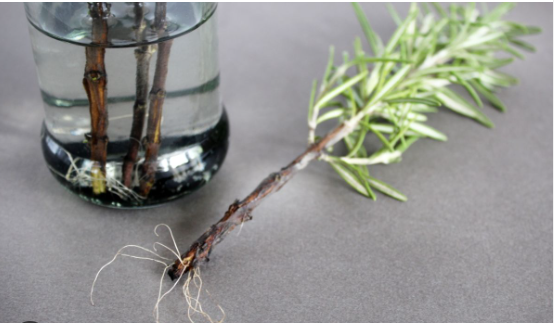
For development to occur and to minimise shock, the water must be at room temperature instead of ice cold. The water may be warm, but it shouldn’t be hot enough to burn the stem. You should change the water to keep it fresh when it becomes hazy. As the water evaporates, you’ll need to refill the glass. Remove any stems from the glass that have not developed roots after a few weeks to prevent the decaying stems from affecting the development of the remaining cuts. When the roots on the cuttings are several inches long, you may put them in the soil. You may transplant them to separate containers for future growth or directly into the garden.
Soil-based roots
Cuttings may also be planted in soil without first being potted. It eliminates the root-watching option but improves root development. Create a mixture for spreading. You can utilise a combination of sand and coconut coir. Coconut coir is a fine blend that enhances root development, water retention, and drainage. The cutting may adapt more quickly to its new environment since the sand aids drainage and more closely mimics its new planting site. However, these materials also lack the nutrients to develop young, delicate roots. Create a mixture for spreading. You can utilise a combination of sand and coconut coir. Coconut coir is a fine blend that enhances root development, water retention, and drainage. The cutting may adapt more quickly to its new environment since the sand aids drainage and more closely mimics its new planting site. However, these materials also lack the nutrients to develop young, delicate roots.
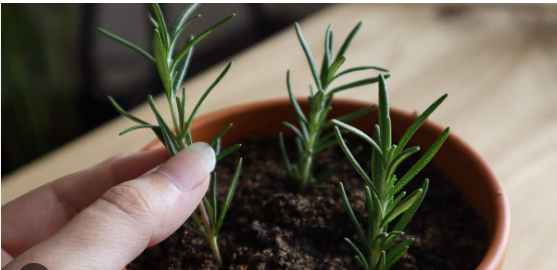
Before you plant anything, make sure all the drainage holes are dry. Then, compact the ingredients by pressing them down firmly. Get a skewer and some dirt, and prepare holes for your cuttings. To plant your cuttings, dig holes and fill them with soil to the first set of leaves. Apply more pressure around the slit as necessary. Put several skewers in the saucepan and set them around the rim. Then, seal the whole pot within a large, transparent plastic bag, such as a resealable sandwich bag. By simulating a little greenhouse around the cuttings, you can maximise the conditions for root development. Keep the pot out of direct sunlight but in a warm area. It’s crucial to maintain a wet growing medium. The cuttings have started to produce roots when new growth appears, and they become difficult to remove from the soil.
Transplanting
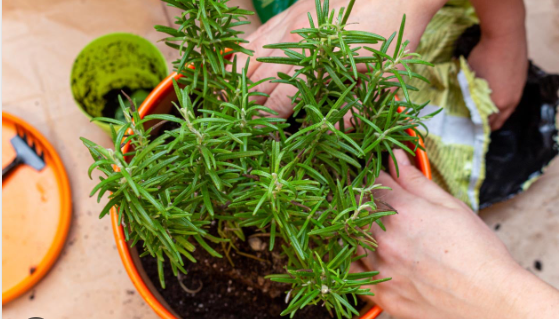
Successful cuttings may be transplanted after a few weeks have passed. Prepare a container of potting soil with good drainage for each cutting, or plant them directly in the garden. To establish themselves and develop into the large, bushy plants you desire, you must give them lots of water and expose them to bright sunshine.
Advantages of Growing the Rosemary Plants from Cutting
Before knowing when to take rosemary cuttings, you must know the reasons to do so. Growing rosemary from cuttings has certain advantages over germinating seeds, including:
1. Early Harvest
Compared to a rosemary plant grown from seed, one rooted from a cutting will be ready for harvest far sooner. It might take a long time for rosemary seeds to germinate and much longer for the plant to reach maturity. However, cutting a rosemary’s stem will grow and become a mature plant in only a few months.
2. More Plants, No Charge
Many cuttings may be taken from a single plant without endangering the mother plant. For example, you may keep the rosemary plants in the window area of your kitchen to fill the air with a pleasant scent whenever you brush up against them.
3. Eliminate Digestive Stress
Indigestion, stomach cramps, gas, bloating, and constipation are some GI issues that rosemary oil may help with. It can control the fluid that is responsible for digesting food. It stimulates the overall appetite and helps regulate bile production, which is critical in digestion.
4. Decrease Anxiety and Stress
Inhaling the scent of rosemary essential oil has been shown to reduce blood levels of the stress hormone cortisol. As a result, stress, anxiety, and anything else that triggers the body’s fight will go away.
5. Encourage Hair Growth
When applied to the scalp, rosemary essential oil stimulates the production of new hair. In addition, it increases blood flow to the scalp, enabling it to grow hair, ward against baldness, or regrow hair in thinning regions.
When to Take Rosemary Cuttings?
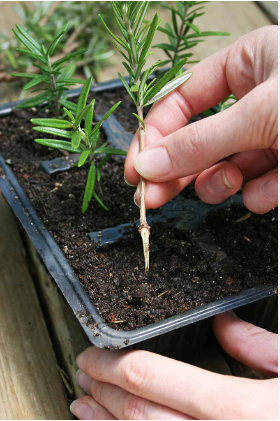
Rosemary should be propagated from cuttings in late spring or early summer when it is actively growing and producing new leaves. If you are wondering when to take rosemary cuttings, it’s before the plant blossoms. However, even if your plant has begun flowering, you might still discover stems that haven’t bloomed. Remember that softwood cuttings of rosemary are all you need for this procedure. Softwood refers to the cuttings taken from the plant’s young growth in the spring. The stems of the cuttings won’t be woody since they originate from tender, immature sprigs. When starting, it’s best to avoid hardwood cuttings since they take much longer to root and are more susceptible to rot.
Tips to Care for Rosemary Plants
It is not sufficient to know when to take rosemary cuttings in the UK; you must know about the basic maintenance. Some suggestions for maintaining a robust and fruitful plant:
- Grow in the sun: In the summer, 6-8 hours of direct sunlight is ideal for rosemary.
- Water the dry soil: Once rosemary is established, it prefers dry conditions. Therefore, water deeply, letting the top inch of soil dry out between watering.
- Report: A rosemary plant kept in a pot may become one foot to three feet tall as the plant grows. When the roots outgrow their pot, keep moving them up.
- Regularly prune rosemary: The more you prune, the fuller the plant will get. Keep the plant compact by cutting it down to the ground after flowering.
Final Thoughts
Rosemary is a popular herb that is mainly known for its ability to enhance the aroma of many foods. Besides this, it offers other health benefits that attract many people toward the plants. Therefore, propagating rosemary is possible with utmost care. But, before that, individuals need to know when to take rosemary cuttingsor the right time for propagating to ensure better results.
There are a few simple steps to propagate rosemary that we have mentioned in the article. So, follow the steps above and get a bushy herb to enhance your surroundings. Also, pay attention to the plant to identify any signs of stress during the first few weeks. Also, ensure the plants are well-watered and get adequate sunlight to ensure they will grow big and bushy plants.
Follow the steps above and get a bushy herb to enhance your surroundings.
Do you have anything in mind regarding rosemary cuttings?
Frequently Asked Questions (FAQs)
Is It Possible to Root Rosemary from Cuttings in Water?
Cuttings of rosemary may be successfully rooted in water; softwood stems are recommended. However, although this approach is quick and straightforward, it has been linked to an increased risk of transplant shock.
When and How to Take the Cuttings from Rosemary?
Rosemary may be planted and grown at certain seasons. So, if you are wondering when to take rosemary cuttings, you need to wait for the plant to develop new growth at least a few inches thick or in the spring or early summer at the latest best time to work on it. Cuttings from softwoods may be rooted more quickly and easily. You want modern, bendable stems that may be white or light green.
What Is the Quickest Way to Propagate Rosemary?
The most efficient and common approach for rosemary propagation is to establish new plants from stem cuttings by rooting them in either water or soil. Unfortunately, it is not possible to propagate the plant from a single leaf or needle; thus, you will need to employ stem cuttings to have any chance of success.
How Long Does Rosemary Cutting Generally Take to Root?
Whether rosemary cuttings are started in water or soil affects how quickly they will root. The stems only take two to four weeks to root in water, but the soil approach usually takes up to eight weeks. Once you see new growth appearing on top, you’ll know they’ve been able to root themselves effectively.
Does Rosemary Cutting Require Sunlight?
In the summer, 6-8 hours of direct sunlight is ideal for rosemary. Water when the soil begins to feel dry. Once rosemary gets established, it prefers dry conditions.




